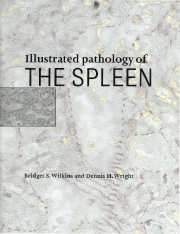Book contents
- Frontmatter
- Contents
- Preface
- Acknowledgements
- 1 Introduction
- 2 Normal structure, development and functions of the spleen
- 3 Post-traumatic and incidentally removed spleens
- 4 The spleen in hereditary blood cell abnormalities and auto-immune disorders
- 5 The spleen in immunodeficiency and systemic infections
- 6 Lymphomas involving the spleen
- 7 The spleen in myeloproliferative disorders
- 8 Pathology of the splenic stroma
- 9 Metastases and miscellaneous conditions
- 10 Summary: some key points in splenic differential diagnosis
- Index
9 - Metastases and miscellaneous conditions
Published online by Cambridge University Press: 14 August 2009
- Frontmatter
- Contents
- Preface
- Acknowledgements
- 1 Introduction
- 2 Normal structure, development and functions of the spleen
- 3 Post-traumatic and incidentally removed spleens
- 4 The spleen in hereditary blood cell abnormalities and auto-immune disorders
- 5 The spleen in immunodeficiency and systemic infections
- 6 Lymphomas involving the spleen
- 7 The spleen in myeloproliferative disorders
- 8 Pathology of the splenic stroma
- 9 Metastases and miscellaneous conditions
- 10 Summary: some key points in splenic differential diagnosis
- Index
Summary
Appearances and primary origins of metastatic cancers involving the spleen
Metastases originating from a wide variety of primary sites have been described in the spleen, sometimes as part of widespread dissemination but often solitary. Compared with the frequency of lymph node spread from carcinomas and melanomas, splenic involvement by metastasis is very rare. This may reflect paucity or absence of afferent lymphatics (see Chapter 2) as a route of entry for metastasizing cells into the spleen. Alternatively, the spleen may offer an unfavourable environment for the growth of tumour micro-emboli. In some cases, splenic involvement by carcinoma may represent direct invasion from metastasis within one or more hilar lymph nodes rather than true metastatic origin within the spleen. Nevertheless, some genuine intrasplenic metastatic growths do occur with no spatial proximity to hilar structures or evidence of trans-capsular spread of tumour into the spleen from an origin in adjacent tissues.
Most metastatic non-lymphoid tumours in the spleen, regardless of their origin, produce localized masses within the tissue (Fig. 9.1), detected by ultrasonography or radiology, or because they cause palpable splenic enlargement. These lesions are often solitary and cystic, mimicking a variety of benign cysts which occur in the spleen (Fig. 9.2). They may be extensively necrotic. In such cases, it may be difficult to confirm the malignant nature of the lesion if few or no remaining tumour cells are viable.
- Type
- Chapter
- Information
- Illustrated Pathology of the Spleen , pp. 151 - 162Publisher: Cambridge University PressPrint publication year: 2000



